St John's Hospital
162 St John's Hill, Battersea, SW11 1SP
Medical dates:
Medical character:
Miscellaneous, chronic tuberculosis and mental observation. Later, geriatric
The Wandsworth and Clapham
Guardians leased land from Earl Spencer on the north side of St John's
Hill and, between 1838-40, a new workhouse was erected with an adjacent
infirmary on its northern side.
In 1868 a much larger infirmary was built in the gardens to the north of the workhouse, comprising four three-storey buildings linked to a central four-storey administration block. It opened in 1870 as the Wandsworth and Clapham Union Infirmary.
In 1886 a new workhouse opened in Garratt lane and the Infirmary took over the St John's Hill workhouse buildings. Over the following years extensions and various changes were made to the buildings. By 1895 3,559 in-patients had been treated, of whom 435 (12%) had died.
In 1898 a Nurses Home was added to the northeast corner of the site. By this time the Infirmary had 32 general wards with ten isolation wards for patients with infectious diseases.
The Infirmary was superseded as a general hospital by St James' Hospital in Balham, which opened in 1911. It cared then mainly for the chronically ill.
In 1920 it was renamed the St John's Hill Infirmary.
In 1930 it came under the control of the LCC and was renamed St John's Hospital. By this time it had 637 beds, but only minor operations were carried out at the Hospital.
During WW2 the Battersea Chest Clinic was set up in the old Board Room as the borough's TB dispensary had been destroyed by bombing.
St John's joined the NHS in 1948 and by 1953 it had 480 beds - 255 for chronically sick women, 120 for chronically sick men, 53 for TB patients and 52 for mental observation. 212 patients were permanently bedridden, some of whom had been transferred to St Pancras Hospital during WW2. Two wards in the old workhouse building were still in use. The mental observation ward was only partly used for those patients, the remainder of the inmates being those suffering from senile dementia.
After the war 17 young chronically sick patients had been admitted from various LCC hospitals so they could be together. It had been intended to transfer them to more suitable accommodation (they had been placed in wards with seriously ill elderly men), but the LCC ceased to have any responsibility when the NHS took over. In 1953 the young patients were given their own ward which had a day room with a TV partitioned off at one end. At this time the cost of an in-patient per week was £9 0s 7d (£9.03) (compared with the Battersea General Hospital in the same Group, which was £16 16s 1d (£16.80) per week).
During the 1970s one of the ward blocks bordering on St John's Hill was demolished and St John's Day Hospital and Chest Clinic built on its site in 1977-1978.
The Hospital closed in 1985. and the site remained derelict for several years.
In 1868 a much larger infirmary was built in the gardens to the north of the workhouse, comprising four three-storey buildings linked to a central four-storey administration block. It opened in 1870 as the Wandsworth and Clapham Union Infirmary.
In 1886 a new workhouse opened in Garratt lane and the Infirmary took over the St John's Hill workhouse buildings. Over the following years extensions and various changes were made to the buildings. By 1895 3,559 in-patients had been treated, of whom 435 (12%) had died.
In 1898 a Nurses Home was added to the northeast corner of the site. By this time the Infirmary had 32 general wards with ten isolation wards for patients with infectious diseases.
The Infirmary was superseded as a general hospital by St James' Hospital in Balham, which opened in 1911. It cared then mainly for the chronically ill.
In 1920 it was renamed the St John's Hill Infirmary.
In 1930 it came under the control of the LCC and was renamed St John's Hospital. By this time it had 637 beds, but only minor operations were carried out at the Hospital.
During WW2 the Battersea Chest Clinic was set up in the old Board Room as the borough's TB dispensary had been destroyed by bombing.
St John's joined the NHS in 1948 and by 1953 it had 480 beds - 255 for chronically sick women, 120 for chronically sick men, 53 for TB patients and 52 for mental observation. 212 patients were permanently bedridden, some of whom had been transferred to St Pancras Hospital during WW2. Two wards in the old workhouse building were still in use. The mental observation ward was only partly used for those patients, the remainder of the inmates being those suffering from senile dementia.
After the war 17 young chronically sick patients had been admitted from various LCC hospitals so they could be together. It had been intended to transfer them to more suitable accommodation (they had been placed in wards with seriously ill elderly men), but the LCC ceased to have any responsibility when the NHS took over. In 1953 the young patients were given their own ward which had a day room with a TV partitioned off at one end. At this time the cost of an in-patient per week was £9 0s 7d (£9.03) (compared with the Battersea General Hospital in the same Group, which was £16 16s 1d (£16.80) per week).
During the 1970s one of the ward blocks bordering on St John's Hill was demolished and St John's Day Hospital and Chest Clinic built on its site in 1977-1978.
The Hospital closed in 1985. and the site remained derelict for several years.
Present status (March 2008)
The site has been redeveloped as the St John Therapy Centre, which opened in 2007. There is a private care home behind the Centre. Many buildings remain at the back , presumably converted into flats.
The site has been redeveloped as the St John Therapy Centre, which opened in 2007. There is a private care home behind the Centre. Many buildings remain at the back , presumably converted into flats.
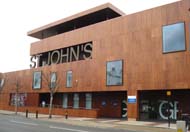
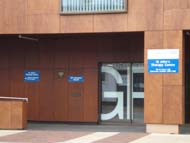
The hulking St John's Therapy Centre, built by Building Better Health at a cost of £7m, under the auspices of the Department of Health's initiative, Local Improvement Finance Trust (LIFT), to improve GP surgeries and community health buildings.
Wandsworth Access Association, inspecting the Centre with a view to disabled patients relocated from the Bolingbroke Hospital using it, found among other problems that the toilets were too small to accommodate a wheelchair. The problem has now been remedied. (At least there were toilets - the preliminary plans for the new RNOH building in Bolsover Street provided NO toilets at all for the patients!)
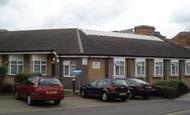
Haydon House, the new mental health care centre
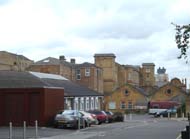
Looking
north down Haydon Way towards the old ward blocks, now converted into
luxury apartments. Haydon House is on the left.
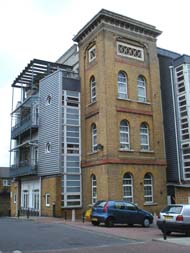
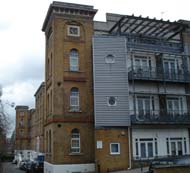
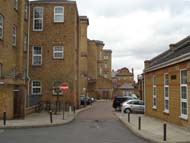
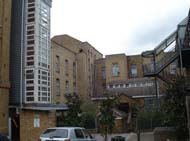




The old ward blocks, now residences in the newly created Haydon Way
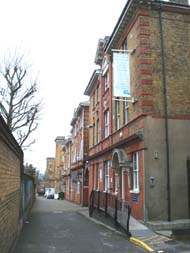
The John Morris House Community Centre, which opened in 2000. The Battersea Churches and Chelsea Housing Trust bought the building in 1996 and initiated the redevelopment of the Hospital site.

The John Morris House Community Centre, which opened in 2000. The Battersea Churches and Chelsea Housing Trust bought the building in 1996 and initiated the redevelopment of the Hospital site.
www.workhouses.org.uk
Return to home page